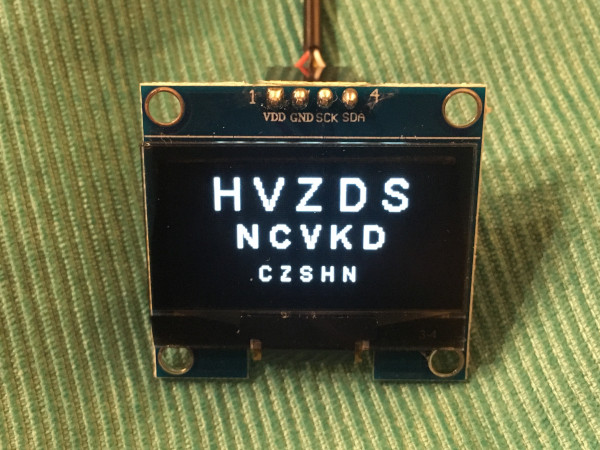by Adrian Glasser
This is a blog about possible applications for Organic Light Emitting Diode (OLED) displays.
OLED displays are small displays that come in range of display resolutions including 128x128 pixels, 128x64 and 128x32. As the name implies, these are self-illuminated displays. They can be controlled with microcontrollers to display text, graphic elements such as lines, triangles, circles, or images. For use with the Arduino family of microcontrollers, they require libraries specific to the driver chips in the OLED displays. The simplest of the OLED displays require only 4 microcontroller pins (therefore only 4 wires), VCC, GND, SCL & SDA. SCL is the clock pin and SDA is the data pin. These 4-pin or 4-wire OLEDs use an Inter-Integrated Circuit serial communication bus (I2C or IIC or (I2C) and the displays can be powered with 3.5 V to 5 V.
The potential applications for these OLED displays are endless, but one potential application is for use as a near letter chart for clinical accommodation testing.
Accommodation is the physiological and optical process whereby the young eye is able to change focus for objects at different distances. As we age, we gradually lose the ability to accommodate with the onset of presbyopia. Presbyopia is caused by natural age-related increase in stiffness of the lens inside the eye. When we are young, the lens is soft and pliable such that the muscles in the eye can act on the lens to change the shape and optical power of the lens. As we age and the lens becomes progressively stiffer, the muscles are no longer able to change the shape and optical power of the lens and the consequence, for many people, is the loss in the ability to focus on near objects.
To measure accommodation first requires the subject being tested to look at and focus on a distant letter chart while the refractive power of the eye is measured. Then the subject must look at and focus on a near letter chart and again have the refractive power of the eye measured. If the eye has active accommodation, the optical power of the eye will change when the subject changes focus from the distant target to the near target.
Normally when measuring accommodation in a clinic in this way, it is necessary to have the room light turned down as much as possible so as to ensure that the pupil of the eye is as large as possible. This is because when making an effort to focus at near, the pupil constricts. The smaller pupil is often more difficult to measure through, so keeping the pupil as large as possible is often advantageous.
An OLED display is ideal for the near stimulus for accommodation testing. Since the OLED is self-illuminated, there is no need to illuminate the display with a separate light source. Since the OLED is self-illuminated, the brightness of the OLED remains constant. Therefore, all the room lights can be turned down and the OLED can serve as the only source of illumination, thereby aiding to keep the pupil as large as possible. The OLED display brightness can also be controlled and varied from the microcontroller with the use of a potnetiometer, for example. So if the OLED is too bright with the room ights turned off, the OLED display can be dimmed.
There is some debate as to whether I2C communication can be accomplished over long distances (long cables or wires). There should not be any debate on this matter as there are simple solutions which include the use of bus buffer chips which are designed for this very purpose. A simpler solution which works perfectly well for many applications is the use of pull-up resistors on the OLED display SCL and SDA pins. Without the use of these pull-up resistors, the OLED displays might remain black when a longer wire is use, but adding appropriate pull-up resistors will solve this issue. For the application described here, a 2-meter wire would be sufficient because most near vision testing would start at a distance of about 1 metre. With the appropriate pull-up resistors, the OLED display shown below works well with a 2-metre cable.
This particular OLED display has a display area a little larger than 34 mm by 19 mm (~1.3 inches wide). This means that the OLED is small in size and light in weight and is therefore ideal for a near letter chart display that can be suspended on a near-point rod. The letter sizes, number of letters, and actual letters displayed can all readily be changed in software from the microcontroller. Indeed, many different kinds of graphics displays, often used for near vision testing, such as a Maltese cross, can also readily be generated and displayed. The microcontroller could be configured with a pushbutton or a rotary-encoder to change what is displayed. The I2C communication also allows these OLD displays to be daisy-chained together, so a separate display could be positioned so that the clinician conducting the near-vision testing can see what is displayed on the display that the subject is looking at. The clinician could then ask the subject to read the letters to be sure that the subject can actually see and recognize the letter. The letter sizes can also be changed and all of this can be implemented under software control right from the microcontroller.
